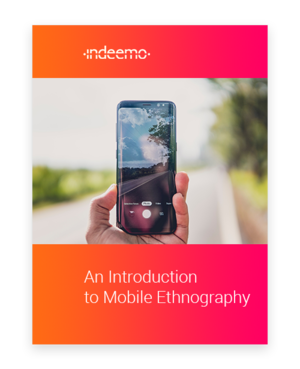Mobile Ethnography White Paper
Learn how Mobile Ethnography can supplement your research projects and generate richer contextual insights for your brands.

Our client, a qualitative research agency, was commissioned by a leading FMCG brand to gain a better insight into consumers’ relationships with a selection of everyday products. The project requirements was to ‘deep dive’ into consumers’ path-to-purchase, consumption behaviors, attitudes, and habits when it comes to selecting food and beverages.
FMCG products often present challenges to researchers because the nature of the products means that they are selected, purchased, prepared, and consumed in very short time-frames. For this reason, understanding rapidly changing emotions and attitudes of respondents through this process was a traditional hurdle for our client.
Spreads are one of the most commonly used staples in most homes. The agency was tasked with understanding the use of spreads in-home, as well as the purchasing preferences of different demographics of women. They understood one thing; the vast selection of butter and spreads in stores made it difficult for consumers to choose.
But that also meant that understanding the consumers’ selection and purchase rationale in-context and in-the-moment was difficult to achieve but important to know.
Going beyond the store, there were even more questions emerging than answers. Because all households were different in so many ways, they could gauge very little about usage.
Who was using butter?
When were they using it?
What made any particular brand the preferred choice in the kitchen?

Our client needed answers and they needed them quickly.
Given the fact that traditional, in-person ethnography tends to be time-consuming and expensive, it is a research methodology that has historically been perceived as being within the budgets of very few brands and as a result, brands and researchers have tended to “brand” ethnography as expensive and not scalable. Consequently, brands have preferred to rely on in-depth interviews and focus groups as a more cost-effective and scalable online qualitative research methodology.
Our client’s objectives were to:
Get a deeper understanding of the usage of spreads in all types of homes.
Understand the path-to-purchase of spreads of families
Gain an authentic insight into thoughts, attitudes, and experiences with regards to spreadable butter.

When our client came to us with this challenge, we worked with them to see how mobile ethnography could supplement this qualitative FMCG project. Our client was clear; focus-groups and in-depth interviews with respondents were going to serve as the basis for the project. But we felt that a mobile diary study would give our clients a better understanding of their respondents in a more cost-effective manner. We set about creating a pre-tasked diary study that would give us a platform to generate better insights.
We assigned 6 different target groups of women, 3 tasks to complete using Indeemo, our mobile ethnography application. This included a path-to-purchase trip to a supermarket, where the respondents took us through their spreadable butter selection process.
Indeemo’s ability to work both offline and online meant that every respondent's deliberation, selection, and purchase were captured ‘in-the-moment’. Even more insightful were the in-context motivations and behaviors that were being captured in these moments. Using real-time push notification probes as respondents stood in front of the butter section in stores, our client was even able to elicit the subconscious pre-purchase thoughts influencing their buying decision
As the diary-study moved to the home, our client started seeing a wide range of uses. The target groups spanned all women of all ages with young and old families of varying sizes, as well as those without families. The range of actors and factors influencing the choice of butter in households was unprecedented.
When our client approached us initially, they had no idea about the why, where, and when moments of butter and spreads usage. But by utilizing a mobile diary study, they quickly placed themselves at the center of consumers' shopping lives.
As the diary-study moved to the home, our client started seeing a wide range of uses. The target groups spanned women of all ages with young and old families of varying sizes, as well as those without families.
Throughout the study, 25 registered respondents uploaded videos over 256 times, giving our client an insight into their lives and the role various butter spreads played in them. This equated to a completion rate of almost 90% over the whole project.
Our client was impressed by the richness and authenticity of the responses from respondents. Beyond the focus groups and interviews, the mobile diary study provided a real-life insight into the usage of butter and spreads that could not be replicated with traditional methods alone. About Indeemo
Indeemo's mobile ethnography app and qualitative research platform help researchers, designers, Insights teams, and brands capture authentic, in-context, in-the-moment behaviors, and feelings that help them better understand what matters to their customers. By merging mobile, video, and private social networking technologies, Indeemo's agile, mobile ethnography solution delivers rich, contextual insights at scale and in real-time.
If you’d like to know more about how Indeemo can help you understand consumers motivations surrounding food and beverages, please get in touch



Learn how Mobile Ethnography can supplement your research projects and generate richer contextual insights for your brands.
